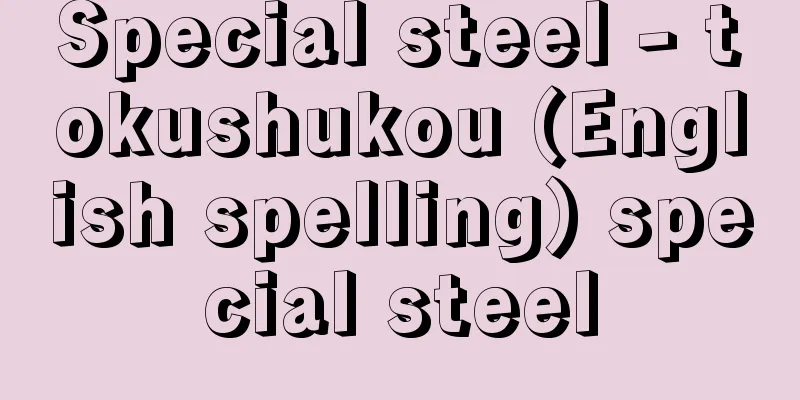Special steel - tokushukou (English spelling) special steel

|
A high-grade steel that has been specially refined and has alloying elements added, as opposed to ordinary steel. In the old technology, ordinary steel was made by oxidizing and removing the carbon contained in pig iron (containing about 4.5% carbon) from a blast furnace in a converter or open hearth, resulting in mild steel (containing about 0.2% carbon). Special steel is made by carefully refining it in an electric furnace or other furnace, and alloying elements are added for special purposes. Therefore, special steel also included steel for machine parts or tools that does not contain alloying elements, such as carbon steel for machine structures and carbon tool steel, but after World War II, steelmaking technology advanced and the term special steel is rarely used anymore. Below, we will discuss steel with added alloying elements, i.e. alloy steel. Steel becomes extremely hard when quenched, and tough when tempered. The thicker the steel, the more difficult it is to cool rapidly, so chromium, manganese, silicon, nickel, molybdenum, boron, etc. are added so that the steel can be quenched even when cooled slowly. Adding about 0.002% boron significantly improves hardenability. Molybdenum is added at about 0.2%, and other alloying elements at around 1%. Steel with about 0.2% carbon and these elements added is called high tensile strength steel or low alloy high tensile strength steel, and is used for construction. Steel with 0.2 to 0.5% carbon and the above alloying elements added is called low alloy steel for machine construction, but because this type of steel is difficult to weld, it is machined to shape and then heat treated, and used for parts that require toughness above all else, such as gears and shafts. For tool steel, which requires hardness and wear resistance, adding the above alloying elements to steel containing 0.5% or more carbon not only increases the hardenability, but also forms very hard carbides such as tungsten carbide and molybdenum carbide, further improving the characteristics as a tool. In addition, alloy steels containing chromium, molybdenum, tungsten, vanadium, etc. do not soften easily even when heated to high temperatures. This characteristic is used in hot work tool steels and heat-resistant steels. High-speed steels are high-alloy steels containing about 18% tungsten (or part of it is replaced with molybdenum), 4% chromium, 1% vanadium, and cobalt, and are used to make drills and cutting tools that do not lose their sharpness even when cut at high speeds. Adding chromium is extremely effective in giving corrosion resistance and oxidation resistance, and steels containing 12% to 30% chromium are called stainless steels and are used as corrosion-resistant and heat-resistant alloys. Superalloys, which replace the iron with nickel or cobalt and add large amounts of molybdenum, tungsten, vanadium, aluminum, etc. to give them high-temperature strength, are called superalloys and are used in the manufacture of gas turbines and jet engines. Steel usually contains around 0.03% impurities such as sulfur and phosphorus. Both of these make the material brittle, and the higher the alloy steel, the more pronounced the adverse effects are. Therefore, the content of these impurities must be reduced before adding alloying elements. For materials used at low temperatures, such as liquefied natural gas storage tanks, there are low-temperature steels with reduced phosphorus and added nickel. [Hajime Sudo] [Reference items] | | | | |Source: Shogakukan Encyclopedia Nipponica About Encyclopedia Nipponica Information | Legend |
|
特別に精錬され、合金元素を添加した高級鋼で普通鋼に対する名称。古い技術では溶鉱炉(高炉)から得られる銑鉄(約4.5%の炭素を含む)を転炉または平炉中で含有炭素を酸化除去して得られた軟鋼(約0.2%の炭素を含む)が普通鋼であり、特殊鋼は改めて電気炉などで精錬を入念に行い、特別の目的のために合金元素が添加された。したがって機械構造用炭素鋼や炭素工具鋼のように合金元素をとくに添加しない機械部材あるいは工具用の鋼をも特殊鋼に含めていたが、第二次世界大戦後に製鋼技術が進歩して、特殊鋼という呼び名もほとんど用いられなくなった。以下では合金元素を添加した鋼、すなわち合金鋼について述べる。 鋼は焼き入れると非常に硬化し、焼き戻すと靭性(じんせい)が出る。肉厚のものほど急冷ができなくなるので、徐冷しても焼きが入るように、クロム、マンガン、ケイ素、ニッケル、モリブデン、ホウ素などを添加する。ホウ素は0.002%程度の添加で顕著に焼入れ性を高める。モリブデンは約0.2%、他の合金元素は1%前後添加する。0.2%程度の炭素を含む鋼にこれらの元素を添加した鋼は高張力鋼(ハイテンhigh tensile strength steel)または低合金高張力鋼とよばれ、建造物に用いられる。0.2~0.5%炭素鋼に前記の合金元素を添加したものは機械構造用低合金鋼であるが、この鋼種は溶接が困難であるから、機械加工によって形状を整えてから熱処理されて、歯車や軸など強靭性をなによりも必要とする部材に用いられる。硬さと耐摩性をまず要求される工具鋼には、0.5%以上の炭素を含む鋼に前記の合金元素を添加すると、焼入れ性が増すのみならず、炭化タングステンや炭化モリブデンなど非常に硬い炭化物が形成されて工具としての特性が一段と向上する。また、クロム、モリブデン、タングステン、バナジウムなどを添加した合金鋼は、高温に加熱されても容易に軟化しない。この特性を利用したのが熱間工具鋼や耐熱鋼である。高速度鋼はタングステン約18%(あるいはその一部をモリブデンで置換)、クロム4%、バナジウム1%のほかにコバルトを含む高合金鋼で、高速切削をしても切れ味が落ちないドリル、バイトなどがつくられる。耐食性や耐酸化性を与えるためにはクロムの添加がきわめて有効で、12%以上30%以下のクロムを添加した鋼をステンレス鋼といい、耐食、耐熱合金として用いる。この鉄分をニッケルやコバルトで置換し、高温強さを与えるために多量のモリブデン、タングステン、バナジウム、アルミニウムなどを添加した超耐熱合金を超合金といい、ガスタービンやジェットエンジンの製造に用いる。 通常、鋼は0.03%前後の硫黄(いおう)やリンなどの不純物を含む。これらはいずれも材質をもろくし、高級な合金鋼ほどその悪影響が強く現れるので、合金元素の添加の前にこれら不純物含有量を下げなければならない。とくに液化天然ガス貯蔵タンクのように低温で使用される材料には、リンを下げ、ニッケルを添加した低温用鋼がある。 [須藤 一] [参照項目] | | | | |出典 小学館 日本大百科全書(ニッポニカ)日本大百科全書(ニッポニカ)について 情報 | 凡例 |
>>: Special company - Tokushukaisha
Recommend
Wang Huang - Wang
…His official title was Wang's Right Army. Hi...
Montauban - Montauban (English spelling)
It is the capital of the Tarn-et-Garonne departme...
Ojou Kichisa - Ojou Kichisa
A character from the Kabuki play "Sannin Kich...
Antal Dorati
An American conductor of Hungarian origin. He stu...
Garimomero tribe - Garimomero tribe
…(1) is often used in reference to the moon, is w...
Ikko Sanzon
A type of halo. The halos of the Shaka Triad, Yaku...
Kainz - Joseph Kainz
German actor. Born in Hungary. He trained at the ...
Ichiryuu Keikomugi - Single-grain wheat
...Over the long history of agriculture, this has...
shepherd
…English villain. He gained notoriety as a burgla...
Garôta de Ipanema (English spelling)
...It was created by composer and pianist Antonio...
Ichikawa Somegoro (first generation)
…(4) 4th generation (1737-1802 | Genbun 2-Kyowa 2...
Chemical machining
A method of processing metal surfaces and shapes ...
Spectrin
…The characteristic of actin filaments is that th...
The Vision of Piers Plowman
A long religious poem attributed to the 14th centu...
Goose neck - Gooseneck
…The calcification of the media varies in degree....









